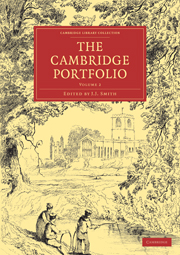Book contents
- Frontmatter
- DIRECTIONS FOR PLACING THE PLATES
- THOMAS HOBSON
- THE WOODWARDIAN MUSEUM
- ANECDOTES. II
- PORTRAITURE OF WILLIAM HARVEY
- THE HALL OF TRINITY COLLEGE
- JESUS COLLEGE
- OLD HOUSES
- CROMWELLI
- SOURCES OF HISTORY. IV
- EGYPTIAN ANTIQUITIES
- A VIEW FROM THE GARDENS OF CHRIST'S COLLEGE
- SAMUEL PEPYS
- KING'S COLLEGE
- THE PUBLIC LIBRARY
- ST. MARY'S CHURCH
- THE EXAMINATIONS
- THE CAMBRIDGE PRESS
- CRANMER
- ST. PETER'S COLLEGE
- MEMOIR OF A PHYSICIAN
- MILTON'S MULBERRY-TREE, AND BUST, IN CHRIST'S COLLEGE
- REMARKS ON THE INFERIOR STYLES OF DOMESTIC ARCHITECTURE
- THE POWTES COMPLAYNTE
- THE CAMBRIDGE SCHOLAR AND THE GHOST OF A SCRAG OF MUTTON
- INDEX
- ERRATA
- Plate section
THE PUBLIC LIBRARY
Published online by Cambridge University Press: 10 November 2010
- Frontmatter
- DIRECTIONS FOR PLACING THE PLATES
- THOMAS HOBSON
- THE WOODWARDIAN MUSEUM
- ANECDOTES. II
- PORTRAITURE OF WILLIAM HARVEY
- THE HALL OF TRINITY COLLEGE
- JESUS COLLEGE
- OLD HOUSES
- CROMWELLI
- SOURCES OF HISTORY. IV
- EGYPTIAN ANTIQUITIES
- A VIEW FROM THE GARDENS OF CHRIST'S COLLEGE
- SAMUEL PEPYS
- KING'S COLLEGE
- THE PUBLIC LIBRARY
- ST. MARY'S CHURCH
- THE EXAMINATIONS
- THE CAMBRIDGE PRESS
- CRANMER
- ST. PETER'S COLLEGE
- MEMOIR OF A PHYSICIAN
- MILTON'S MULBERRY-TREE, AND BUST, IN CHRIST'S COLLEGE
- REMARKS ON THE INFERIOR STYLES OF DOMESTIC ARCHITECTURE
- THE POWTES COMPLAYNTE
- THE CAMBRIDGE SCHOLAR AND THE GHOST OF A SCRAG OF MUTTON
- INDEX
- ERRATA
- Plate section
Summary
The principal public buildings of the University stand in immediate contiguity to one another. A full account of them should comprise a description of their aspect, structure, and the condition of the establishment to which each appertains. The buildings which contain the Library and Schools form a hollow square: they are of two stories and were erected at various dates. The changes that have taken place in the structure and the condition of the Library at different times are necessarily so closely connected that they may be traced together.
Previous to 1589, the Public Library of the University contained 177 volumes in “wretched condition.” These and the meditative employment they supplied gave way to more practical study in 1546, when the room they occupied was by a Grace converted to the purpose of a Divinity School: but in 1586 by the same authority it recovered its former character and appropriation. In 1649, the Library was increased by taking into it the Greek Schools.
The present front was for a long time spoken of as the new building: but now another rising building has succeeded to that title. On the 29th of April, 1755, the Duke of Newcastle, then Chancellor, laid the first stone. The site of the building, as well as the ground before it, had been occupied by tenements belonging to King's College, and were sold by them to the University under an Act passed for empowering the University to improve their Library.
- Type
- Chapter
- Information
- The Cambridge Portfolio , pp. 438 - 446Publisher: Cambridge University PressPrint publication year: 2010First published in: 1840



